功能派翻译理论介绍(中英文版)
功能派翻译理论与中文电影片名的英译
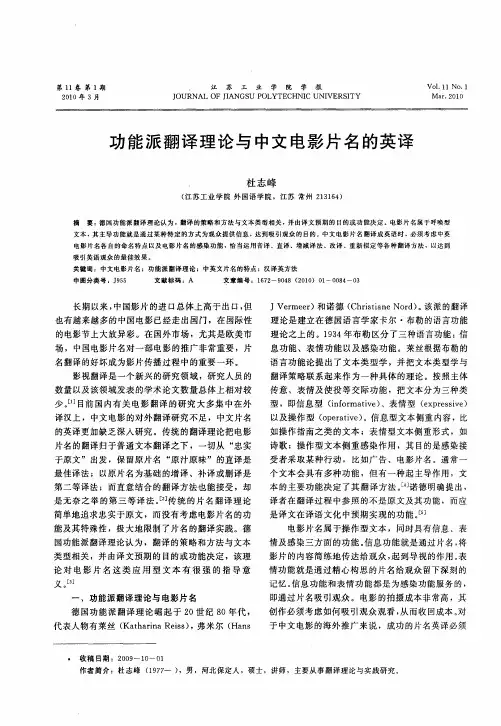
译汉上 ,中文电影 的对外 翻译研究 不足 ,中文片名 的英译更加缺 乏深入研 究 。传 统 的翻译理论 把 电影
以及 操作 型 (prt e 。信 息型 文本侧重 内容 ,比 o eai ) v 如操作 指南之 类 的文 本 ;表情 型文本侧重 形式 ,如 诗歌 ;操作型 文本侧 重感 染作 用 ,其 目的是感染接
德 国功能 派 翻译 理 论 崛起 于 2 O世 纪 8 O年代 ,
代 表人物有莱 丝 ( taiaRe s ,弗米尔 ( n Kah r i ) n s Ha s
・
收 稿 日期 :2 0 — 1 一0 09 O 1
作 者 简 介 :杜 志 峰 (9 7 ) 1 7一 ,男 .河北 保 定 人 ,硕 士 ,讲 师 ,主要 从 事 翻 译 理 论 与 实 践 研 究 。
的电影 节上大放异 彩 。在 国外市 场 ,尤其是欧美 市
场 ,中国电影 片名对 一部 电影 的推广 非常重要 ,片 名翻译 的好 坏成为影 片传播 过程 中的重要 一环 。
影视 翻译是一个 新兴 的研究领 域 ,研 究人员 的 数量 以及该 领域发表 的学术 论文数 量总体 上相对较 少 。] [ 目前 国 内有 关 电影 翻译 的 研究 大 多集 中在外 1
中 图分 类 号 :J5 95 文献 标 码 :A 文章 编 号 :17 — 94 (0 0 0 —0 8 —0 6 2 08 2 1 ) 1 0 4 3
长期 以来 , 国影 片的进 口总体上 高于 出 口, 中 但 也有越来 越多 的中国 电影 已经走 出 国门 ,在 国际性
JVemer 和诺 德 ( h i in r ) 该 派的翻译 r e) C r t eNod 。 sa
杜 志峰 .功 能 派 翻译 理 论 与 中文 电 影 片 名 的 英 译
功能翻译理论概述
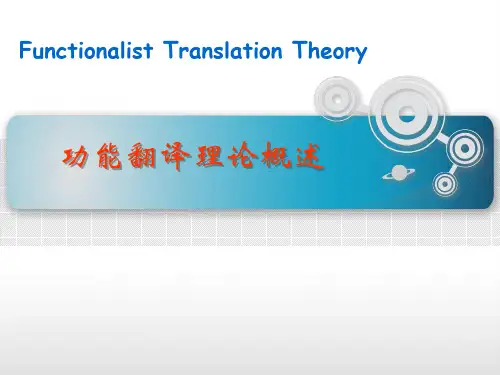
功能翻译理论概述
contents
功能翻译理论的文献综述 核心理论——目的论简介 功能翻译理论在各类翻译领域的应用 对功能翻译理论的评价
结语及参考文献
Translation Time
theorists
Works
Opinions
Remarks
• “目的原则” (skopos rule)指的是译文与“翻译 指令”之间的关系,即:如果译文与翻译的目的 不同于原文的目的,译文必须满足翻译指令的要 求。
目的论的三原则
在这个系统中,忠实原则从属于连贯原 则,而连贯原则又从属于目春光一二!(《牡丹亭》)
图3:有关翻译目的论的文章类型比例图
38%
20% 5%
37%
研究性文章文学 性
文学类应用性文 章
非文学类应用性 文章
评价性文章
结果分析
1.研究内容单一 从统计分析我们可以看到,尽管近年来有关功能主义翻译目的论在
我国的研究文章数量不断增多,但多是在翻译策略方面特别是在非文 学类翻译策略研究方面。功能主义目的论在翻译批评、翻译理论和翻 译教学中的研究相对缺乏。
但是要使目的论完全适应各种题材,仍需要对许 多方面进行反思。
参考文献
[1] Baker, Mona. Routledge Encyclopedia of Translation Studied. Shanghai: Shanghai Foreign Language Education Press.2004.
[2] Gentzler, Edwin. Contemporary Translation Theories(Revised Second Edition).Shanghai: Shanghai Foreign Language Educat ion Press.2004.
德国的功能派翻译理论
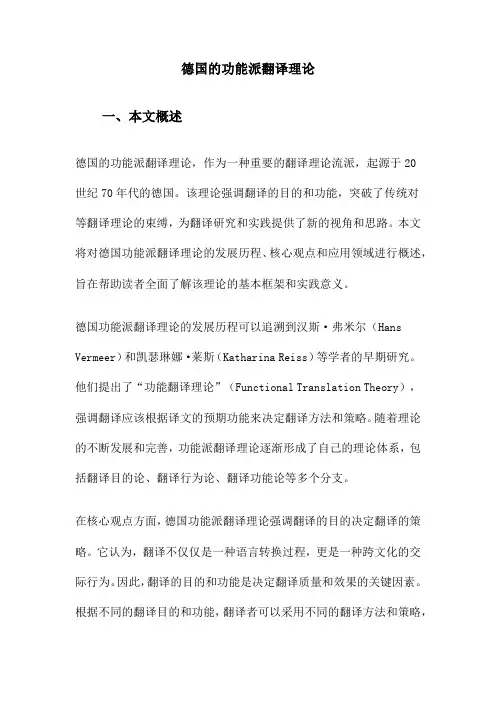
德国的功能派翻译理论一、本文概述德国的功能派翻译理论,作为一种重要的翻译理论流派,起源于20世纪70年代的德国。
该理论强调翻译的目的和功能,突破了传统对等翻译理论的束缚,为翻译研究和实践提供了新的视角和思路。
本文将对德国功能派翻译理论的发展历程、核心观点和应用领域进行概述,旨在帮助读者全面了解该理论的基本框架和实践意义。
德国功能派翻译理论的发展历程可以追溯到汉斯·弗米尔(Hans Vermeer)和凯瑟琳娜·莱斯(Katharina Reiss)等学者的早期研究。
他们提出了“功能翻译理论”(Functional Translation Theory),强调翻译应该根据译文的预期功能来决定翻译方法和策略。
随着理论的不断发展和完善,功能派翻译理论逐渐形成了自己的理论体系,包括翻译目的论、翻译行为论、翻译功能论等多个分支。
在核心观点方面,德国功能派翻译理论强调翻译的目的决定翻译的策略。
它认为,翻译不仅仅是一种语言转换过程,更是一种跨文化的交际行为。
因此,翻译的目的和功能是决定翻译质量和效果的关键因素。
根据不同的翻译目的和功能,翻译者可以采用不同的翻译方法和策略,以实现最佳的交际效果。
在应用领域方面,德国功能派翻译理论广泛应用于各种翻译实践,包括文学翻译、商务翻译、法律翻译、医学翻译等。
它不仅为翻译实践提供了理论指导,还为翻译质量的提高提供了有效保障。
该理论也促进了翻译学科的多元化发展,为翻译研究注入了新的活力。
德国功能派翻译理论作为一种重要的翻译理论流派,为翻译研究和实践提供了新的视角和思路。
本文将对这一理论进行全面概述,帮助读者深入了解其发展历程、核心观点和应用领域。
二、德国功能派翻译理论概述德国功能派翻译理论,也被称为“功能主义翻译理论”或“目的论翻译理论”,起源于20世纪70年代的德国。
这一理论的核心观点是,翻译并非简单的语言转换过程,而是一种具有特定目的和功能的社会行为。
功能派翻译理论强调翻译过程中译者的主观能动性,认为译者应根据翻译的目的和受众的需求,选择适当的翻译策略和方法。
功能派翻译理论综述
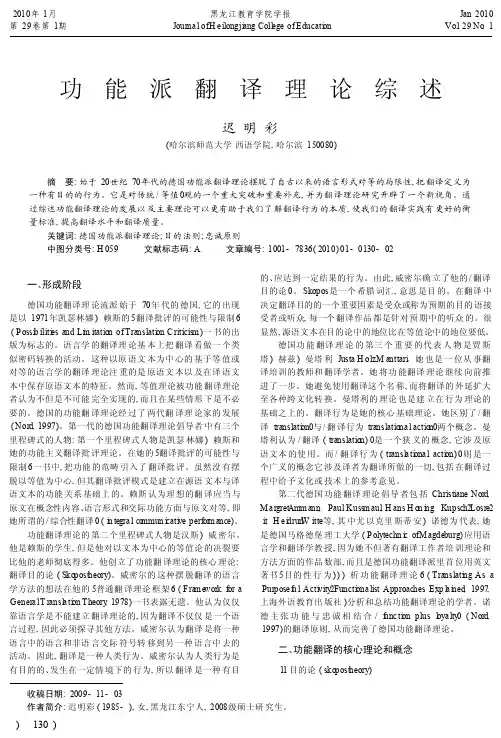
2010年1月第29卷第1期黑龙江教育学院学报Journa l ofH e ilongji ang Coll ege of Educati on Jan .2010Vo.l 29No .1收稿日期:2009-11-03作者简介:迟明彩(1985-),女,黑龙江东宁人,2008级硕士研究生。
功能派翻译理论综述迟明彩(哈尔滨师范大学西语学院,哈尔滨150080)摘 要:始于20世纪70年代的德国功能派翻译理论摆脱了自古以来的语言形式对等的局限性,把翻译定义为一种有目的的行为。
它是对传统/等值0观的一个重大突破和重要补充,并为翻译理论研究开辟了一个新视角。
通过综述功能翻译理论的发展以及主要理论可以更有助于我们了解翻译行为的本质,使我们的翻译实践有更好的衡量标准,提高翻译水平和翻译质量。
关键词:德国功能派翻译理论;目的法则;忠诚原则中图分类号:H 059 文献标志码:A 文章编号:1001-7836(2010)01-0130-02一、形成阶段德国功能翻译理论流派始于70年代的德国,它的出现是以1971年凯瑟林娜)赖斯的5翻译批评的可能性与限制6(P ossi b iliti es and Li m itatio n of Translati on C riticis m )一书的出版为标志的。
语言学的翻译理论基本上把翻译看做一个类似密码转换的活动。
这种以原语文本为中心的基于等值或对等的语言学的翻译理论注重的是原语文本以及在译语文本中保存原语文本的特征。
然而,等值理论被功能翻译理论者认为不但是不可能完全实现的,而且在某些情形下是不必要的。
德国的功能翻译理论经过了两代翻译理论家的发展(Nord ,1997)。
第一代的德国功能翻译理论倡导者中有三个里程碑式的人物:第一个里程碑式人物是凯瑟林娜)赖斯和她的功能主义翻译批评理论。
在她的5翻译批评的可能性与限制6一书中,把功能的范畴引入了翻译批评。
虽然没有摆脱以等值为中心,但其翻译批评模式是建立在源语文本与译语文本的功能关系基础上的。
功能学派翻译理论全解

针对翻译研究中对等理论的薄弱环节,德国的功能翻译理论于上 世纪70年代后期而生,它是以目的论( Skopostheory) 为核心的 强调文本和翻译功能的一种翻译流派, 它的出现反映了翻译的 全面转向,即由原先占主导地位的语言学及侧重形式的翻译理 论转向更加注重功能和社会文化因素的翻译观 。 功能目的翻译论旨在于翻译应该基于以译文和译文读者的反应 来进行翻译,而不是依据传统理论中的翻译应以原文和原文读 者的反应进行 。可以说,目的论摆脱了传统翻译理论,从另一 个新的角度来进行翻译研究.
早期理论:
主要围绕对等概念展开,她认为翻译追求的对等应该是语 篇层面的对等,而非词、句的对等,所以主张将翻译策略 和语言功能、语篇类型以及文章体裁结合起来考察。作为 长期从事翻译培训的教师,莱斯的功能研究法起初是为了 使译本评估系统化,提出将文本功能作为翻译批评的标准, 从原文和译文二者功能之间的关系来评价译文。
在论文《翻译的抉择:类型、体裁及文本的个性》一文中,莱 斯在语篇类型学的基础上,细致地分析了翻译过程的步骤,以 及语篇类型和体裁对翻译交际中出现的变化所起的作用。她把 翻译过程分为 分析阶段要明确原文的功能类型(text type)和文本体裁 (text variety),然后进行文本外部语言分析。 重述阶段是在上一步的基础上组织目标文本的结构,文本 功能决定一般翻译方法,体裁语言和篇章结构。文章还提议建 立翻译类型学。
后期理论:
在自身翻译实践的启发下,她认识到在翻译实际中不可能实现 真正的对等,在有些情光转向翻译的目的,并和弗 米尔一起成为翻译研究目的论的倡导者。
• 莱斯反对莱比锡学派学者卡德含混的语篇概念,她 借鉴了卡尔·比勒对语言功能的三分法,将语篇类 型分为信息型、表达型和操作型三种类型,并指出 语篇类型决定具体的翻译方法。一篇文章可能同时 具备几种功能,但总有一种处于主导地位,能否传 达原文的主导功能是评判译文的重要因素。 •同时,她认为目标文本的形态首先应该由目标语境 中所要求的功能和目的决定,目的随接受者的不同 而改变。
功能派翻译理论
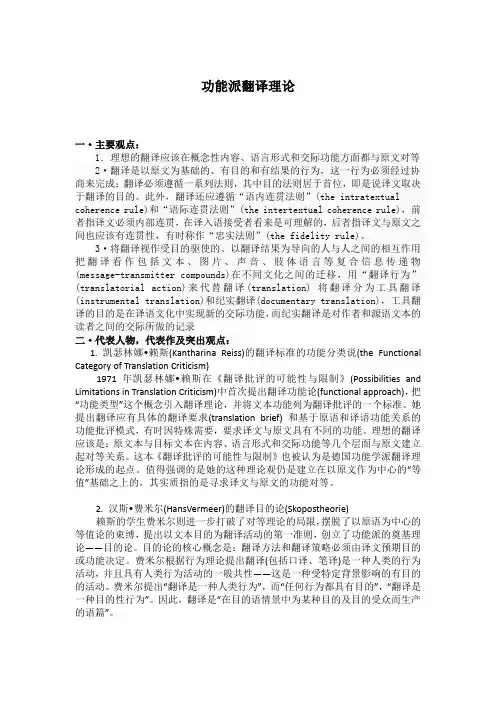
功能派翻译理论一·主要观点:1.理想的翻译应该在概念性内容、语言形式和交际功能方面都与原文对等 2·翻译是以原文为基础的、有目的和有结果的行为,这一行为必须经过协商来完成;翻译必须遵循一系列法则,其中目的法则居于首位,即是说译文取决于翻译的目的。
此外,翻译还应遵循“语内连贯法则”(the intratextual coherence rule)和“语际连贯法则”(the intertextual coherence rule),前者指译文必须内部连贯,在译入语接受者看来是可理解的,后者指译文与原文之间也应该有连贯性,有时称作“忠实法则”(the fidelity rule)。
3·将翻译视作受目的驱使的、以翻译结果为导向的人与人之间的相互作用把翻译看作包括文本、图片、声音、肢体语言等复合信息传递物(message-transmitter compounds)在不同文化之间的迁移,用“翻译行为”(translatorial action)来代替翻译(translation) 将翻译分为工具翻译(instrumental translation)和纪实翻译(documentary translation),工具翻译的目的是在译语文化中实现新的交际功能,而纪实翻译是对作者和源语文本的读者之间的交际所做的记录二·代表人物,代表作及突出观点:1. 凯瑟林娜•赖斯(Kantharina Reiss)的翻译标准的功能分类说(the Functional Category of Translation Criticism)1971年凯瑟林娜•赖斯在《翻译批评的可能性与限制》(Possibilities and Limitations in Translation Criticism)中首次提出翻译功能论(functional approach),把“功能类型”这个概念引入翻译理论,并将文本功能列为翻译批评的一个标准。
德国功能派翻译理论_1672918320
的语文化背景下的译文 接收
者所理解和接纳;
•-’ -
' - . ,'-•'•'CFi.i'rt* • L •*_»*1 -••*. 7 • k.•
昏喝涵_ -4 ;么祕釋蠢/ ;
?、■:I:?獨痛衡,•站 /
广
•“篇际连贯”(inter-
1/ textual coherence),或
目的论是_美尔在1978年出版的<< 普遍翻译结构》里第一次提出的.
M的论的理论基础是“行 为理 论"” (action theroy).行为理论 认为, 任何行为都是有箕目的的,或更 为精 确地说,“目的”是人_zr为的属 性.因 此,翻译作为一种行为,其方法 和策略 也取决于目的.“目的论”还杂 、T.和.: 了“交际理论” (theory of 象communication)和“文化理 论” (theroy of culture)等理论,认为 任何行为都是在特定时间、地点和特 定 文化背景下为某个特定目的和特定 接收 者制作的一个文本.
能K分为爻献型翻捧(documentary
ttrraannssllaattiioonn)),和提工出具了型忠翻诚译((loinysatlrtuym)原enWtaJl ,补充了目的论的缺陷
• Skopos是希腊语,意为 “厨的”。
.•.翻译目的论
(skopostheories)是将
、:. " Skopos概念运用于瓣
德国功能派翻译理论
Functional School
人
动、厶
匕 匕
丰
和完
3
建
功冃 派 译 理
核_
_德国的功能派翻译理论
·国外翻译理论·德国的功能派翻译理论仲伟合 钟 钰 翻译早在公元前就已成为人们争论不休的话题。
从公元前罗马帝国的翻译学家们对“词对词”翻译与“意义对意义”翻译展开辩论至今,翻译理论领域可以说是“百花齐放,百家争鸣”,特别是近代,随着人类认知能力的发展,新的翻译理论不断涌现。
二十世纪七十年代,德国就出现一派翻译理论———功能派翻译理论。
功能派认为翻译(包括口、笔译)是一种行为。
其理论的重点表现在如下三方面:(1)对翻译实质的阐释(2)对翻译过程参与者的角色分析(3)功能翻译原则的提出。
本文拟从这三方面入手,介绍功能派翻译理论。
1.功能派的形成及重要理论谈到功能派,就不得不提及三位功能派翻译理论杰出的贡献者凯瑟林娜·雷斯(Katharina Reiss)、汉斯·威密尔(Hans. Vermeer)、贾斯塔·赫滋·曼塔利(Justa Holz M anttari)。
雷斯首先于1971年在她的著作《翻译批评的可能性与限制》(Pos sibilities and Limitation of Translatio n Criticism)一书中将文本功能列为翻译批评的一个标准,即从原文、译文两者功能之间的关系来评价译文。
当时,雷斯的理论建立在对等理论基础之上。
因此,这种关系实际上指的是原文与译文的功能对等。
雷斯的学生威密尔则突破了对等理论的限制,以文本目的(skopos)为翻译过程的第一准则,发展了功能派的主要理论:目的论(skopostheory)。
威密尔所提出的目的论(sko-po stheory)是功能派翻译理论中最重要的理论。
skopos是希腊词,意思是“目的”。
根据目的论,所有翻译遵循的首要法则就是“目的法则”:翻译行为所要达到的目的决定整个翻译行为的过程,即结果决定方法。
这个目的有三种解释:译者的目的(如赚钱);译文的交际目的(如启迪读者);和使用某种特殊翻译手段所要达到的目的(如为了说明某种语言中语法结构的特殊之处而采用按其结构直译的方法)。
功能学派翻译理论
General description about functionalist school
The school holds that translation is a particular variety of translational action based on source text. Any translational action, including translation itself, is an action. Any action has an aim or purpose. The Skopostheorie brought forth by Vermeer is the most important functionalist translation theory.
• Within the realm of functional linguistics is
Justa Holz-Mänttäri’s theory of translational action that takes into account practical issues while, at the same time, placing the emphasis firmly on the reader of the TT. This means, for example, that things like the source text type may be altered( 改变), if it is deemed to be inappropriate for the target culture.
Holz-Mäntarri (行为理论)
• Holz-Mäntarri (1984) • Translational action(行为理论) A communicative process involving: • The initiator(翻译的发起者) • The commissioner(委托人) • The ST producer(原文生产者) • The TT producer(译文生产者) • The TT user(译文使用者) • The TT receiver(译文接受者)
德国功能派翻译理论简介
pragmatic texts (instructions for use, advertisements) than in literary translation. Different or even contradictory standards for
the selection of transfer procedures are thus set up for different
(theory of translation action)
功能加忠诚理论 (function plus loyalty)
感谢下载
6
Basic Aspects of Skopostheorie
感谢下载
7
Skopos Rule
“The translation purpose justifies the translation procedures.”
感谢下载
8
翻译会遇到的三大类purpose
• The general purpose aimed at by the translator in the translation process(perhaps ‘to earn a living’)
• The communicative purpose aimed at by the target text in the target situation (perhaps ‘to instruct the reader’)
- 1、下载文档前请自行甄别文档内容的完整性,平台不提供额外的编辑、内容补充、找答案等附加服务。
- 2、"仅部分预览"的文档,不可在线预览部分如存在完整性等问题,可反馈申请退款(可完整预览的文档不适用该条件!)。
- 3、如文档侵犯您的权益,请联系客服反馈,我们会尽快为您处理(人工客服工作时间:9:00-18:30)。
功能派翻译理论介绍(其中中文内容来源于百度百科)20世纪70年代,功能派翻译理论兴起于德国。
其发展经过了以下几个阶段。
第一阶段:凯瑟琳娜·莱斯首次把功能范畴引入翻译批评,将语言功能,语篇类型和翻译策略相联系,发展了以源文与译文功能关系为基础的翻译批评模式,从而提出了功能派理论思想的雏形。
莱斯认为理想的翻译应该是综合性交际翻译,即在概念性内容,语言形式和交际功能方面都与原文对等,但在实践中应该优先考虑的是译本的功能特征。
第二阶段:汉斯·弗米尔(Vermeer)提出了目的论,将翻译研究从原文中心论的束缚中摆脱出来。
该理论认为翻译是以原文为基础的有目的和有结果的行为,这一行为必须经过协商来完成,翻译必须遵循一系列法则,其中目的法则居于首位。
也就是说,译文取决于翻译的目的。
此外,翻译还须遵循“语内连贯法则”和“语际连贯法则”。
前者指译文必须内部连贯,在译文接受者看来是可理解的,后者指译文与原文之间也应该有连贯性。
这三条原则提出后,评判翻译的标准不再是“对等”,而是译本实现预期目标的充分性。
弗米尔还提出了翻译委任的概念,即应该由译者来决定是否,何时,怎样完成翻译任务。
也就是说,译者应该根据不同的翻译目的采用相应的翻译策略,而且有权根据翻译目的决定原文的哪些内容可以保留,哪些需要调整或修改。
弗米尔认为,翻译中的最高法则应该是“目的法则”。
也就是说,翻译的目的不同,翻译时所采取的策略、方法也不同。
换言之,翻译的目的决定了翻译的策略和方法。
第三阶段:贾斯塔·霍茨—曼塔里借鉴交际和行为理论,提出翻译行为理论,进一步发展了功能派翻译理论。
该理论将翻译视作受目的驱使的,以翻译结果为导向的人与人之间的相互作用。
该理论和目的论有颇多共同之处,弗米尔后来也将二者融合。
第四阶段:克里斯汀娜·诺德全面总结和完善功能派理论。
克里斯汀娜·诺德首次用英语系统阐述了翻译中的文本分析所需考虑的内外因素,以及如何在原文功能的基础上制定切合翻译目的的翻译策略。
克里斯汀娜·诺德对功能派各学说进行了梳理,并且提出译者应该遵循“功能加忠诚”的指导原则,从而完善了该理论。
目的论认为,所有翻译活动遵循的首要原则是“目的原则”,即翻译应能在译入语情境和文化中,按译入语接受者期待的方式发生作用。
翻译行为所要达到的目的决定整个翻译行为的过程,即结果决定方法。
但翻译活动可以有多个目的,这些目的进一步划分为三类:(1)译者的基本目的(如谋生);(2)译文的交际目的(如启迪读者);(3)使用某种特殊的翻译手段所要达到的目的(如为了说明某种语言中的语法结构的特殊之处采用按其结构直译的方式)。
但是,通常情况下,“目的”指的是译文的交际目的,即“译文在译入语社会文化语境中对译入语读者产生的交际功能”。
(Venuti:2001)因此,译者应在给定的翻译语境中明确其特定目的,并根据这一目的来决定采用何种翻译方法— 直译、意译或介于两者之间。
连贯性(coherence rule)指译文必须符合语内连贯(intra—textual coherence)的标准,即译文具有可读性和可接受性,能够使接受者理解并在译入语文化及使用译文的交际语境中有意义。
忠实性原则(fidelity rule)指原文与译文之间应该存在语际连贯一致(inter—textual coherence)。
这相当于其他翻译理论所谓的忠实于原文,但与原文忠实的程度和形式取决于译文的目的和译者对原文的理解。
总之,这三大原则构成了翻译目的论的基本原则,但是连贯性原则、忠实性原则必须服从于目的原则,这是目的论的首要原则。
In the 1970s, Skopos Theory emerged in Germany. Its development has gone through the following four stages.Firstly, Katharina Reiss introduced the functional element into translation criticism for the first time, linked the language function, text type and translation strategy together, and developed a translation criticism model based on the relationship between the source text and the function of the translation, thus putting forward the basic framework of the functional theory. Reiss believes that the ideal translation should be a comprehensive communicative translation, that is, it is equivalent to the original text in terms of conceptual content, language form and communication function. But in practice, priority should be given to the functional characteristics of the translation. Reiss is currently considered to be the co-founder of Skopos Theory, along with Hans Vermeer.Secondly, Vermeer put forward Skopos Theory and got rid of translation research from the theory shackles of seeing the original text as the core. The theoryholds that translation is a purposeful and fruitful behavior based on the original text, which must be completed through negotiation, and the translation must follow a series of principles, of which the skopos principle is in the first place. That is to say, translation depends on the purpose. In addition, translation must follow the principle of coherence in inner-lingual and inter-lingual aspects. The former means that the target language must be internally coherent, which is understandable to the readers of the target language; and the latter means that there should also be consistency between the target text and the original text. After these three principles are put forward, the criterion for criticizing translation is no longer "being equivalent", but the degree of the translation to achieve the expected goal. Vermeer also put forward the concept of “commission”, that is, it is up to the translator to decide whether, when and how to complete the translation task. That is to say, the translator should adopt the corresponding translation strategy according to different translation purposes, and has the right to decide which content of the original text can be remained and what needs to be adjusted or modified.Vermeer believes that the highest principle in translation should be the “skopos principle”. That is to say, different purposes of translation decide the different strategies and methods adopted in translation. In other words, the purpose of translation determines the translation strategies and methods.Thirdly, Justa Holz-Mänttäri proposed the translatorial action theory, and further developed the Skopos Theory. This theory regards translation as a purpose-driven, result-oriented interaction among people. This theory and Skopos Theory have a lot in common, and Vermeer later merged the two.Fourthly, Christina Nord comprehensively summarizes and improves the functional translation theories. For the first time, Christina Nord systematically explained in English the internal and external factors that need to be considered in text analysis in translation. And she also explained how to formulate a translation strategies suitable for the translation purposes on the basis of the functions of the original texts. Christina Nord sorted out the functional translation theories andproposed that translators should follow the guiding principles of "skopos and fidelity", thus perfecting the theory.According to Skopos Theory, the primary principle followed by all translation activities is the “skopos principle”, that is, translation should be able to play a role in the context and culture of translation in the way expected by the readers of the target text. The purpose of the translation behavior determines the whole process of the translation activity, that is, the result determines the methods. However, translation activities can have multiple purposes, which are further divided into three categories: (1) the basic purpose for the translator (such as making a living); (2) the communicative purpose of the translation (such as enlightening the reader); (3) the purpose to be achieved by using a special translation method (such as to explain the special grammatical structure in a language. It is literally translated according to its structure). However, in general, the “purpose” refers to the communicative purpose of the translation, that is, the communicative function of the translation for the readers in the social and cultural context of the translation. Therefore, the translator should clarify its specific purpose in a given translation context and decide which translation method to use - literal translation, free translation or in between.Coherence principle means that the translation must meet the standard of intra-textual coherence, that is, the translation is readable and acceptable, so that the readers of the target text can understand and use the target text in the culture of the target language.The fidelity principle means that there should be inter-textual coherence between the original text and the target text. This is equivalent to the translation theories named loyalty to the original text, but the degree and form of loyalty to the original text depends on the purpose of the translation and the translator’s understanding about the original text.In a word, these three principles constitute the core principles of Skopos Theory, but the coherence principle and fidelity principle must be subordinate to the skopos principle, which is the primary principle of the theory.Following he guidance of three principles of Skopos Theory and its three principles, namely, skopos rule, coherence rule and fidelity rule, this paper focuses on summarizing the appropriate principles and strategies for translation of corporate annual report so that the theories of such texts will be enriched, and at the same time, good translation of a corporate annual report will enables the foreign investors and partners better understand the circumstances of production and operation of the corporate and will encourage more investors to invest.。
